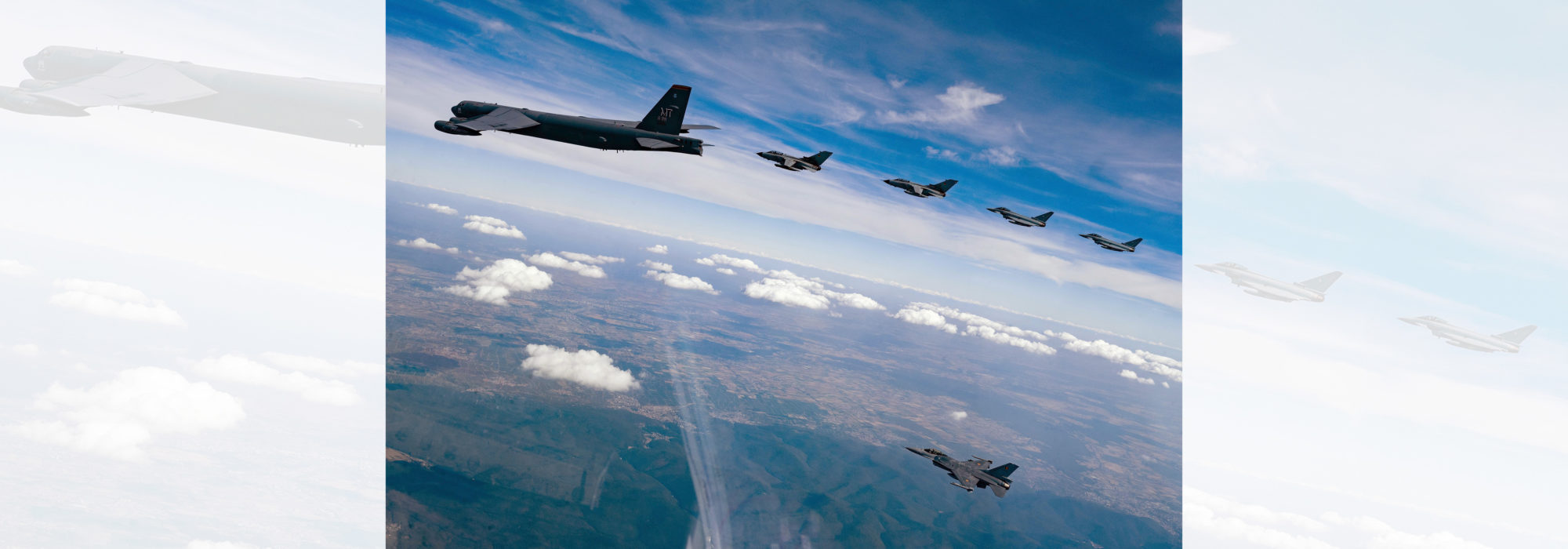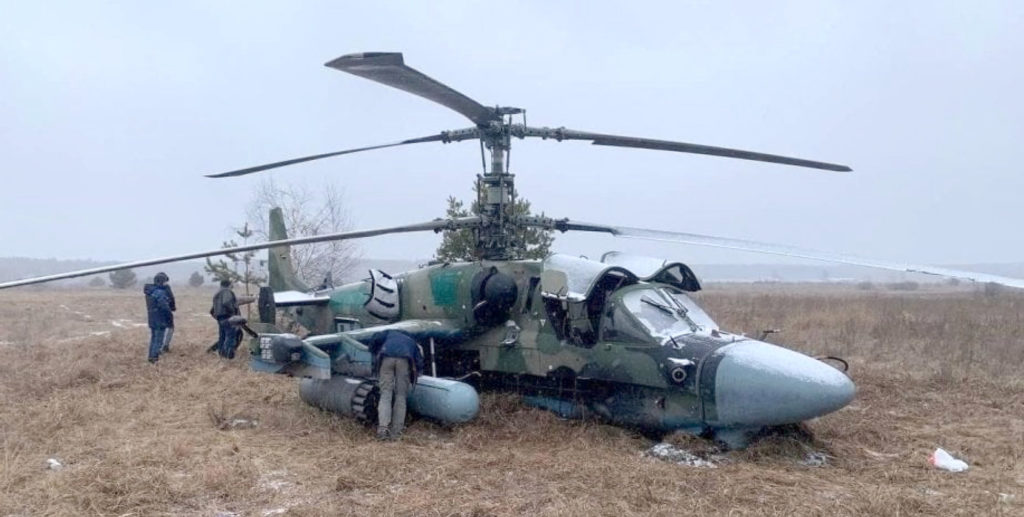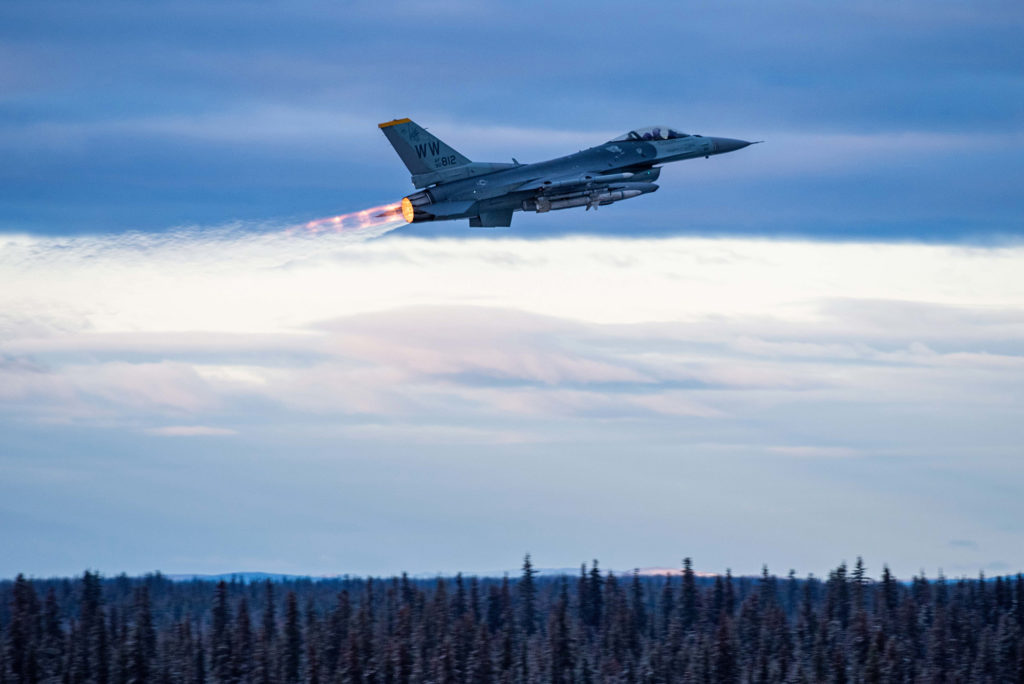NATO, Russia to Hold Nuclear Exercises Despite Tensions
By Chris Gordon
Russia and NATO will go ahead with large-scale nuclear exercises in the coming weeks despite concern over Russian President Vladimir Putin’s hints that the Ukraine war might prompt him to turn to his nuclear arsenal, U.S. and NATO officials said.
The NATO exercise, called Steadfast Noon, involves American nuclear-capable B-52 bombers and fighter jets, which will not carry live munitions, White House National Security Council strategic communications coordinator John Kirby told reporters Oct. 13.
The upcoming NATO exercise involving 14 countries has been long planned, and NATO Secretary General Jens Stoltenberg said delaying or canceling the exercise would send the wrong message about NATO’s resolve in the face of Russian aggression.
“It would send a very wrong signal if we suddenly now canceled a routine, long-time planned exercise because of the war in Ukraine. That would be absolutely the wrong signal to send,” Stoltenberg said. “NATO’s firm, predictable behavior, our military strength, is the best way to prevent escalation.”
The U.S. twice put off routine tests of its Minuteman III missile this year, the first time to avoid inflaming tensions with Russia during the Ukraine crisis and the second time to avoid any miscalculation on China’s part as the Chinese military engaged in a show of force near Taiwan. A Minuteman III test launch eventually took place Aug. 16.
U.S. officials predicted that Russia would soon go ahead with its own large-scale nuclear exercises. The Russian drills would be the second since February 2022. Putin oversaw the February exercise that tested sea, land, and air-based ballistic and cruise missiles and other weapons.
“We expect Russia to conduct its annual strategic nuclear exercise—they call it GROM—as early as this month,” Kirby added.
The Western officials cautioned that the Russian exercise was expected and did not appear to be linked to Putin’s suggestions that Moscow might resort to nuclear weapons in the face of setbacks in Ukraine
In a national address Sept. 21, Putin warned that “Russia will use all the instruments at its disposal to counter a threat against its territorial integrity.” He added, “This is not a bluff.”
“We will monitor that as we always do,” Stoltenberg said of the upcoming Russian exercise. “And, of course, we will remain vigilant, not least in light of the veiled nuclear threats and the dangerous rhetoric we have seen from the Russian side.”
Some nuclear policy experts expressed concern that Russian and NATO nuclear exercises might heighten apprehensions as each side seeks to determine what options might be tested.
“The events are normal,” said Hans Kristensen of the Federation of American Scientists in an interview. “But we don’t know, of course, what’s being exercised, whether that is also normal.”
The Russians, for their part, might portray the NATO exercise as an ominous development and use it as pretext to escalate their activities in the region
“That is definitely a danger,” Kristensen added.
The Western officials stressed that the NATO exercise will take place more than 600 miles away from Russia and does not involve a Ukraine scenario. “This exercise is not linked to any real-world events or what Russia is doing,” Kirby said.
US, Allies Pledge Improved Air Defenses for Ukraine
By Chris Gordon
The United States and allies will help Ukraine build a more comprehensive air defense system to protect key targets from Russian attacks by cruise missiles, ballistic missiles, and aircraft, U.S. officials said Oct. 12.
“What Ukraine is asking for and what we think can be provided is an integrated air and missile defense system,” Gen. Mark A. Milley, Chairman of the Joint Chiefs of Staff, said as representatives from about 50 nations met in Brussels. “That doesn’t control all the airspace over Ukraine. But they are designed to control priority targets that Ukraine needs to protect.”
Russia launched a barrage of missiles and airstrikes against a variety of civilian targets in Ukrainian cities, including its capital, Kyiv, on Oct. 10 in retaliation for the bombing of a key bridge linking Russia to the occupied Crimean Peninsula.
“These attacks killed and injured civilians and destroyed targets with no military purpose,” President Joe Biden said in a statement, calling the Russian strikes “utter brutality.”
Ukraine renewed its plea for better air defense systems to protect the population following the attacks, and the so-called Contact Group countries responded favorably.
U.S. Secretary of Defense Lloyd J. Austin III said help will come soon. “The systems will be provided as fast as we can physically get them there,” Austin said at his news conference with Milley. “We’re going to do everything we can, as fast as we can to help the Ukrainian forces get the capability they need to protect the Ukrainian people. That’s very, very important to us.”
The allied officials did not say when such defenses might be put in place and acknowledged connecting different pieces from a myriad of nations would be a technical and logistical challenge and would require training of Ukrainian forces
“The task will be to bring those together, get them deployed, get them trained because each of these systems is different,” Milley said.
Ukraine would also have to develop a detection and command and control system and link all the components together.
“It’s quite complicated from a technical standpoint,” Milley said. “It is achievable, and that’s what we’re aiming at.”
The U.S. leaders detailed several specific systems they said could help form the basis of Ukraine’s new air defenses, in addition to systems such as Soviet-era S-300 systems already in use that have “been very effective,” according to Milley. Advanced systems, such as the National Advanced Surface-to-Air Missile System (NASAMS) are already in the pipeline but will take years to be fully deployed.
For example, Milley noted the I-HAWK, a legacy U.S. Army medium-range surface-to-air system which he said the Ukrainian government has specifically asked for. Milley and Austin also mentioned Germany’s InfraRed Imaging System Tail (IRIS-T) system, which is now being delivered. The possibility of U.S.-made Patriot batteries and Israeli defenses was floated by Milley, though he acknowledged such systems were among those that could be used rather than concrete offers from a particular country. Ukraine has repeatedly asked for Patriot systems and Israel’s Iron Dome.
Some experts cautioned that it would be difficult to build an exhaustive air defense system for Ukraine and that an ad-hoc system would have to be adopted in practice.
“It may be something closer to interoperability, or frankly, it may just be instead of integration, aggregation,” Tom Karako of the Center for Strategic and International Studies said. “But it’s the right aspiration. The threat makes it necessary to think imaginatively about these things.”
Neither side has been able to control the skies over Ukraine with their air force, despite Russia’s overwhelming relative advantage as one of the world’s biggest air forces. U.S. leaders have noted that Ukraine’s ability to deny Russia air superiority has prevented Russia from making sweeping gains on the battlefield by taking out the Ukrainian military from the air and allowing Russian ground forces to operate unmolested.
Much of the world’s attention had shifted to the war of attrition occurring in the east and south of the country as Ukraine fights to regain control of its territory using artillery and ground forces.
Russia, however, possesses long-range weapons, primarily air-launched cruise missiles that it can fire from bombers inside Russian airspace, as well as ballistic missiles.
These missiles can make it through to targets inside Ukraine due to the lack of a comprehensive air defense system Ukraine’s allies now say they will work to help provide. Some defenses the U.S. supplied early in the war, such as man-portable Stinger missiles that can be fired at low-flying planes and helicopters, are useless in the face of the standoff weapons Russia is implementing. According to the U.S. and Ukraine, thousands of Iranian-made drones have also been ordered by Russia, though Ukraine has had better success against those weapons due to their slow speed and low attitude.
In the future, Ukraine wants a system that can defend against both planes and missiles at low, medium, and high attitude.
“It’s a mix of all these that deny the airspace,” Milley said. “You’re trying to create a defensive system.”
F-16s Intercept Russian Bombers Near Alaska
By Greg Hadley
A pair of U.S. Air Force F-16s intercepted two Russian bombers flying near Alaska on Oct. 17, NORAD announced. The bombers never entered U.S. or Canadian airspace. Officials said they did not see the Russian planes as a threat or provocation.
“No indication that there was any unsafe, unprofessional behavior,” Pentagon Press Secretary Brig. Gen. Pat Ryder told reporters. “They did not pose a threat.”
The Tu-95 Bear-H bombers were tracked entering the Alaskan Air Defense Identification Zone or ADIZ. An ADIZ can include international airspace to help identify approaching aircraft early. The Alaskan ADIZ covers a large area over the Pacific.
The Alaskan NORAD Region detected, tracked, and positively identified the bombers entering and operating in the ADIZ before dispatching two F-16s to intercept them. NORAD’s press release did not specify which units the F-16s belonged to.
The 354th Fighter Wing at Eielson Air Force Base operates F-16s. RED FLAG-Alaska 23-1, the latest installment in the regular Red Flag series of exercises, took place Oct. 16-21, with F-16s from the 35th Fighter Wing at Misawa Air Base, Japan, flying in the area.
In its release, NORAD officials stressed that the Russian bombers flying in the ADIZ “is not seen as a threat nor is the activity considered provocative.”
“NORAD tracks and positively identifies foreign military aircraft that enter the ADIZ” and “routinely monitors foreign aircraft movements and, as necessary, escorts them from the ADIZ,” the statement added.
In September, NORAD announced it had identified and tracked “two Russian maritime patrol aircraft” in the Alaskan ADIZ. Similar incidents occurred in March and January of 2021.
None of those instances, however, involved Russian bombers, and no fighters were sent to intercept those aircraft. The last time NORAD announced that it had identified any Russian bombers in the ADIZ was in September 2020, and the last time it announced that it sent fighters to intercept any aircraft was in August 2020.
This most recent incident comes amid increased tension between the U.S. and Russia. Moscow’s invasion of Ukraine has sparked international outrage. America has imposed severe sanctions on Russia and sent billions of dollars in military aid to Ukraine.
Early in October, Russia and NATO said they would proceed with large-scale nuclear exercises in the coming weeks, even as Russian President Vladimir Putin has engaged in nuclear saber-rattling that has raised fears he might use his arsenal. The NATO exercise, called Steadfast Noon, is centered at Kleine Brogel Air Base, Belgium.


